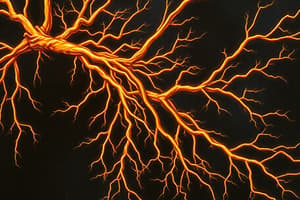Podcast
Questions and Answers
What is the primary distinction between electrical and chemical transmission?
What is the primary distinction between electrical and chemical transmission?
- Electrical transmission uses neurotransmitters while chemical transmission does not.
- Electrical transmission relies on ion channels, while chemical transmission relies on vesicles and neurotransmitters. (correct)
- Electrical transmission occurs across synaptic clefts, chemical transmission does not.
- Electrical transmission is slower than chemical transmission.
What role do MEPPs play in synaptic transmission?
What role do MEPPs play in synaptic transmission?
- They provide evidence of quantal release of neurotransmitters at the neuromuscular junction. (correct)
- They indicate the release of multiple neurotransmitter vesicles simultaneously.
- They are responsible for the generation of action potentials in the pre-synaptic neuron.
- They represent the total summation of all synaptic activity at a post-synaptic neuron.
Which structural feature is critical to the function of the neuromuscular junction?
Which structural feature is critical to the function of the neuromuscular junction?
- A high density of voltage-gated sodium channels on the post-synaptic membrane.
- Presence of myelinated axons for rapid signal conduction.
- The presence of active calcium pumps in the post-synaptic neuron.
- The separation of pre-synaptic and post-synaptic neurons by the synaptic cleft. (correct)
How do temporal and spatial summation primarily differ?
How do temporal and spatial summation primarily differ?
What molecule is primarily responsible for the quantal release of neurotransmitters?
What molecule is primarily responsible for the quantal release of neurotransmitters?
Which statement correctly describes the historical discovery of the synapse?
Which statement correctly describes the historical discovery of the synapse?
What is the primary role of Ca2+ in synaptic communication?
What is the primary role of Ca2+ in synaptic communication?
What determines whether a postsynaptic cell will fire an action potential?
What determines whether a postsynaptic cell will fire an action potential?
Which substance is NOT involved in reducing vesicle release at the synapse?
Which substance is NOT involved in reducing vesicle release at the synapse?
What occurs at the axon hillock in relation to action potentials?
What occurs at the axon hillock in relation to action potentials?
Which scenario describes a suprathreshold postsynaptic response?
Which scenario describes a suprathreshold postsynaptic response?
Which condition is most likely to decrease neurotransmitter release at a synapse?
Which condition is most likely to decrease neurotransmitter release at a synapse?
What is the consequence of a resting synapse that is exposed to curare?
What is the consequence of a resting synapse that is exposed to curare?
What is the characteristic behavior of graded potentials in the cytoplasm?
What is the characteristic behavior of graded potentials in the cytoplasm?
Which component of neuronal communication is primarily responsible for integrating signals?
Which component of neuronal communication is primarily responsible for integrating signals?
What is the effect of EPSP on a neuron's likelihood to fire an action potential?
What is the effect of EPSP on a neuron's likelihood to fire an action potential?
Which of the following accurately describes IPSP?
Which of the following accurately describes IPSP?
What is the primary role of EPSP and IPSP in synaptic communication?
What is the primary role of EPSP and IPSP in synaptic communication?
What occurs when EPSPs and IPSPs interact?
What occurs when EPSPs and IPSPs interact?
Which statement is true regarding the nature of EPSP and IPSP?
Which statement is true regarding the nature of EPSP and IPSP?
How do EPSP and IPSP contribute to spatial and temporal summation?
How do EPSP and IPSP contribute to spatial and temporal summation?
Which scenario lessens the chance of a neuron firing an action potential?
Which scenario lessens the chance of a neuron firing an action potential?
Why are EPSPs considered excitatory?
Why are EPSPs considered excitatory?
Flashcards are hidden until you start studying
Study Notes
Learning Outcomes
- Understand distinctions between electrical transmission (heart) and chemical transmission (neural synapses).
- Recognize structural features of the neuromuscular junction (NMJ).
- Explain quantal release mechanism of neurotransmitters.
- Differentiate between miniature end plate potentials (MEPPs) and end plate potentials (EPPs).
- Clarify temporal and spatial summation concepts.
Concept of the Synapse
- Discovery of the synaptic cleft by Sherrington in the early 1900s.
- Synaptic transmission relies on chemical neurotransmitters, as demonstrated by Loewi in the 1920s.
Synaptic Communication
- Calcium ions (Ca2+) play a crucial role in synaptic communication.
- Voltage-gated Ca2+ channels open upon action potential arrival.
- Ca2+ entry triggers exocytosis of neurotransmitter-filled vesicles.
- Neurotransmitters diffuse across the synaptic cleft to activate postsynaptic neurons.
Subthreshold and Suprathreshold Postsynaptic Responses
- Subthreshold responses exhibit graded potentials and diminish quickly.
- Suprathreshold responses can trigger action potentials depending on the depolarization level at the axon hillock.
Graded Potentials
- Initiated by stimuli causing localized depolarization.
- The magnitude of the potential can decrease rapidly over distance.
Action Potential Propagation
- Action potentials propagate along the axon, reaching the presynaptic terminal.
Integration of EPSPs and IPSPs
- Excitatory postsynaptic potentials (EPSPs) sum to depolarize the neuron, promoting action potential firing.
- Inhibitory postsynaptic potentials (IPSPs) contribute to hyperpolarization, reducing action potential likelihood.
- The balance of EPSPs and IPSPs determines neuronal firing.
Drugs & Neurotransmission
- Factors affecting vesicle release include low calcium levels, high magnesium levels, curare (a toxin), and botulinum toxin (Botox).
- These factors impair neurotransmission by disrupting the normal release of neurotransmitters.
Knee Jerk Reflex
- Illustrates communication across neural networks in response to stimuli.
- Involves muscle spindles detecting stretch and eliciting a reflexive response.
Studying That Suits You
Use AI to generate personalized quizzes and flashcards to suit your learning preferences.



